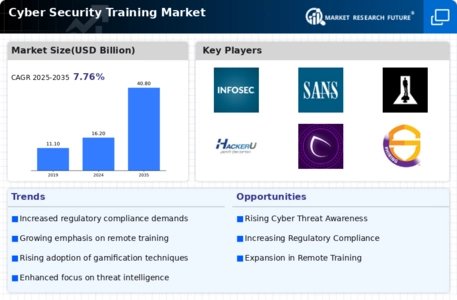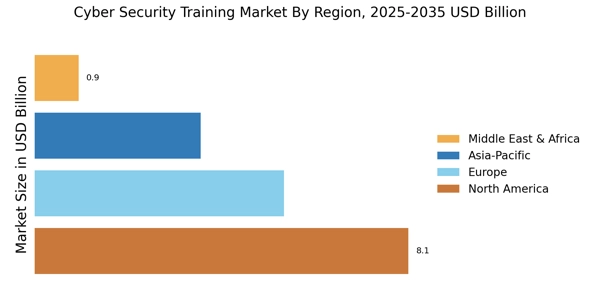Rising Cyber Threats
The Cyber Security Training Market is experiencing a surge in demand due to the increasing frequency and sophistication of cyber threats. Organizations are recognizing the necessity of equipping their employees with the skills to identify and mitigate potential risks. According to recent data, cybercrime is projected to cost businesses over 10 trillion dollars annually by 2025. This alarming statistic underscores the urgency for comprehensive training programs that can effectively prepare personnel to combat these threats. As a result, investments in cyber security training are likely to escalate, reflecting a proactive approach to safeguarding sensitive information and maintaining operational integrity.
Increased Remote Work
The Cyber Security Training Market is witnessing a transformation driven by the rise of remote work arrangements. As organizations adapt to flexible work environments, the attack surface for cyber threats expands, necessitating enhanced training for employees working outside traditional office settings. Data indicates that remote work has led to a 400% increase in cyber attacks targeting remote workers. This alarming trend highlights the critical need for training programs that address the unique challenges posed by remote work, such as secure access to company resources and recognizing phishing attempts. As a result, organizations are likely to prioritize cyber security training to protect their remote workforce.
Technological Advancements
The Cyber Security Training Market is being shaped by rapid technological advancements that necessitate continuous learning and adaptation. Emerging technologies such as artificial intelligence, machine learning, and cloud computing are transforming the cyber security landscape, creating new vulnerabilities and attack vectors. Organizations are increasingly aware that their employees must be trained to understand these technologies and their implications for security. As a result, there is a growing demand for training programs that incorporate the latest technological developments and equip employees with the skills to navigate this evolving environment. This trend suggests that the market for cyber security training will continue to expand as organizations seek to stay ahead of potential threats.
Growing Regulatory Requirements
The Cyber Security Training Market is significantly influenced by the evolving landscape of regulatory requirements. Governments and regulatory bodies are increasingly mandating that organizations implement robust cyber security measures, including employee training. For instance, regulations such as the General Data Protection Regulation (GDPR) and the Health Insurance Portability and Accountability Act (HIPAA) necessitate that employees are well-versed in data protection protocols. This regulatory pressure is driving organizations to invest in training programs that not only comply with legal standards but also enhance overall security posture. Consequently, the demand for specialized training solutions is expected to rise as companies strive to meet these compliance obligations.
Rising Awareness of Cyber Security
The Cyber Security Training Market is benefiting from a heightened awareness of cyber security issues among organizations and individuals alike. As high-profile data breaches and cyber incidents make headlines, there is a growing recognition of the importance of cyber security training. Companies are increasingly investing in training programs to foster a culture of security awareness among employees. Research indicates that organizations with comprehensive training programs can reduce the risk of security incidents by up to 70%. This statistic illustrates the potential impact of effective training on organizational security. Consequently, the demand for cyber security training is likely to grow as organizations strive to enhance their security posture and protect sensitive information.


















Leave a Comment